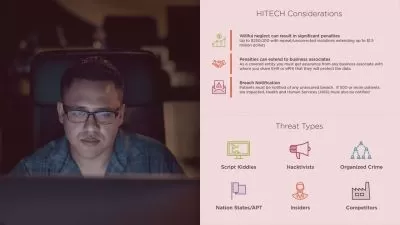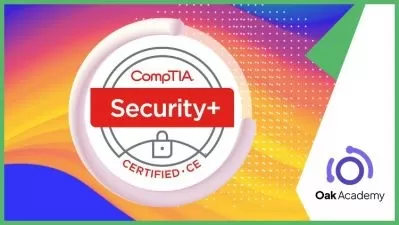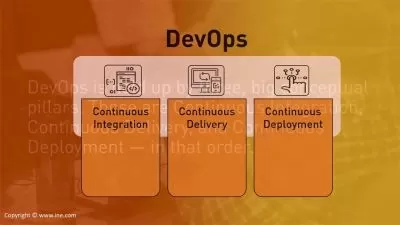CompTIA Security+ (SY0-701)
Stone River eLearning
30:19:54
Description
Certificate Course
What You'll Learn?
- Explain types of malware, Compare and contrast various types of attacks, Analyze potential indicators of compromise.
- Install and configure network components, Given a scenario, use the appropriate tool to assess organizational security.
- Implement secure network architecture concepts,Explain secure systems design
- Install and configure identity and access services. Implement identity and access management controls.
- Explain the importance of policies, plans, and procedures. Summarize business impact analysis concepts.
- Compare and contrast basic concepts of cryptography. Given a scenario, install and configure wireless security settings.
- Explain the importance of threat intelligence. Given an incident, utilize basic forensic tools.
- Compare and contrast various types of controls. Explain the importance of policies, plans, and procedures related to organizational security.
Who is this for?
What You Need to Know?
More details
DescriptionThe new CompTIA Security+ (SY0-701) represents the latest and greatest in cybersecurity, covering the most in-demand skills related to current threats, automation, zero trust, IoT, risk – and more. Once certified, you’ll understand the core skills needed to succeed on the job – and employers will notice too. The Security+ exam verifies you have the knowledge and skills required to:
· Assess the security posture of an enterprise environment and recommend and implement appropriate security solutions.
· Monitor and secure hybrid environments, including cloud, mobile, Internet of Things (IoT), and operational technology.
· Operate with an awareness of applicable regulations and policies, including principles of governance, risk, and compliance.
· Identify, analyze, and respond to security events and incidents.
CompTIA Security+ is compliant with ISO 17024 standards and approved by the U.S. DoD to meet directive 8140/8570.01-M requirements. Regulators and government rely on ANSI accreditation because it provides confidence and trust in the outputs of an accredited program.
This course is designed to equip you with the knowledge and skills required to excel in the dynamic field of cybersecurity and achieve the CompTIA Security+ certification.
This course is designed to equip you with the knowledge and skills required to excel in the dynamic field of cybersecurity and achieve the CompTIA Security+ certification.
Who this course is for:
- The CompTIA Security+ certification is designed for IT professionals who want to establish a career in cybersecurity.
- The certification is suitable for anyone looking to validate their knowledge and skills in foundational cybersecurity concepts, regardless of their specific job role within the IT industry.
The new CompTIA Security+ (SY0-701) represents the latest and greatest in cybersecurity, covering the most in-demand skills related to current threats, automation, zero trust, IoT, risk – and more. Once certified, you’ll understand the core skills needed to succeed on the job – and employers will notice too. The Security+ exam verifies you have the knowledge and skills required to:
· Assess the security posture of an enterprise environment and recommend and implement appropriate security solutions.
· Monitor and secure hybrid environments, including cloud, mobile, Internet of Things (IoT), and operational technology.
· Operate with an awareness of applicable regulations and policies, including principles of governance, risk, and compliance.
· Identify, analyze, and respond to security events and incidents.
CompTIA Security+ is compliant with ISO 17024 standards and approved by the U.S. DoD to meet directive 8140/8570.01-M requirements. Regulators and government rely on ANSI accreditation because it provides confidence and trust in the outputs of an accredited program.
This course is designed to equip you with the knowledge and skills required to excel in the dynamic field of cybersecurity and achieve the CompTIA Security+ certification.
This course is designed to equip you with the knowledge and skills required to excel in the dynamic field of cybersecurity and achieve the CompTIA Security+ certification.
Who this course is for:
- The CompTIA Security+ certification is designed for IT professionals who want to establish a career in cybersecurity.
- The certification is suitable for anyone looking to validate their knowledge and skills in foundational cybersecurity concepts, regardless of their specific job role within the IT industry.
User Reviews
Rating
Stone River eLearning
Instructor's Courses
Udemy
View courses Udemy- language english
- Training sessions 110
- duration 30:19:54
- English subtitles has
- Release Date 2024/06/23
















